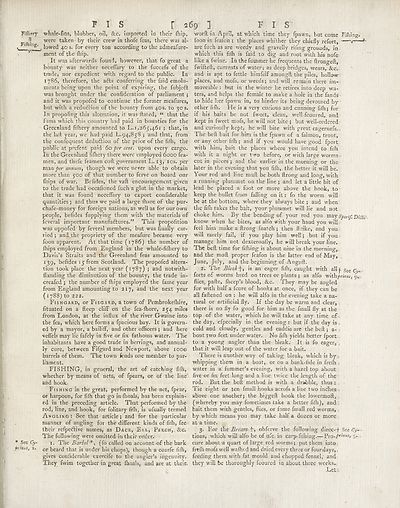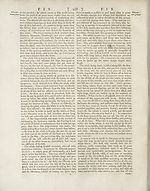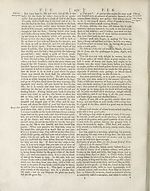Encyclopaedia Britannica > Volume 7, ETM-GOA
(291) Page 269
Download files
Complete book:
Individual page:
Thumbnail gallery: Grid view | List view

FIS r 269 ] F I S
Fiffieiy whale-fins, blubber, oil, &c. imported in their {hip,
H were taken by their crew in thofe feas, there was al-
» 1 ing‘ . lowed 40 s. for every ton according to the admeafurc-
- ment of the (hip.
It was afterwards found, however, that fo great a
bounty was neither neceffary to the fuccefs of the
trader nor expedient with regard to the public. In
1786, therefore, the afts conferring the faid emolu¬
ments being upon the point of expiring, the fubjeft
was brought under the confideration of parliament;
and it was propofed to continue the former meafures,
but with a redu&ion of the bounty from 40s. to 30 s.
In propofing this alteration, it was ftated, “ that the
firms which this country had paid in bounties for the
Greenland fifhery amounted to L. 1,265,461 > that, in
the lail year, we had paid L.94,858 ; and that, from
the consequent dedudtion of the price of the fifh, the
public at prefent paid 60 per cent, upon every cargo.
In the Greenland fifhery there were employed 6000 fea-
men, and thefe feamen coft government L. 13, 10s. per
man per annum, though we were never able to obtain
more than 500 of that number to ferve on board our
(hips of war. Befides, the vaft encouragement given
to the trade had occafioned fuch a glut in the market,
that it was found neceffary to export confiderable
quantities; and thus we paid a large (hare of the pur-
chafe-money for foreign nations, as well as for our own
people, befides fupplying them with the materials of
feveral important manufaftures.” This propofition
was oppofed by feveral members, but was finally car¬
ried ; and the propriety of the meafure became very
foon apparent. At that time (1786) the number of
{hips employed from England in the whale-filhery to
Davis’s Straits and the Greenland feas amounted to
139, befides 15 from Scotland. The propofed altera¬
tion took place the next year (1787) ; and notwith-
fianding the diminution of the bounty, the trade in-
creafed ; the number of {hips employed the fame year
from England amounting to 217, and the next year
(1788)to 222.
Fishgard, or Fisgard, a town of Pembrokefhire,
fituated on a fteep cliff on the fea-lhore, 254 miles
from London, at the influx of the river Gwaine into
the fea, which here forms a fpacious bay. It is govern¬
ed by a mayor, a bailiff, and other officers; and here
veffels may lie fafely in five or fix fathoms water. The
inhabitants have a good trade in herrings, and annual¬
ly cure, between Fifgard and Newport, above too©
barrels of them. The town fends one member to par¬
liament.
FISHING, in general, the art of catching fifh,
whether by means of nets, of fpears, or of the line
and hook.
Fishing in the great, performed by the net, fpear,
or harpoon, for fifh that go in {hoals, has been explain¬
ed in the preceding article. That performed by the
rod, line, and hook, for folitary fifh, is ufually termed
Angling : See that article; and for the particular
manner of angling for the different kinds of fifh, fee
their refpe&ive names, as Dace, Eel, Perch,. &c.
The following were omitted in their order.
• See Cy- 1. The Barbel*, (fo called on account of the bark
frjtius, 2. or beard that is under his chops), though a coarfe fifh,
gives confiderable exercife to the angler’s ingenuity.
They fwim together in great Ihoals, and are at their.
worff in April, at which time they fpawn, but come Fifliing.
foon in feaion : the places whi ther they chiefly refort,
are fuch as are weedy and gravelly rifing grounds, in
which this fifh is faid to dig and root with his nofe
like a fwine. In the fummer he frequents the ftrongeft,
fwifteft, currents of water; as deep bridges, wears, &c.
and is apt to fettle himfelf amongft the piles, hollow
places, and mofs, or weeds; and will remain there im¬
moveable : but in the winter he retires into deep wa¬
ters, and helps the female to make a hole in the fands
to hide her fpawn in, to hinder its being devoured by
other fifli. He is a very curious and cunning fifh; for
if his baits be not fweet, clean, well fcoured, and
kept in fweet mofs, he will not bite ; but well-ordered
and curioufly kept, he will bite with great eagernefs.
The bell bait for him is the fpawn of a falmon, trout,
or any other fifh ; and if you would have good fport
with him, bait the places where you intend to fifli
with it a night or two before, or with large worms
cut in pieces ; and the earlier in the morning or the
later in the evening that you fifh, the better it will be.
Your rod and line muff be both flrong and long, with
a running plummet on the line ; and let a little bit of
lead be placed a foot or more above the hook, to
keep the bullet from falling on it: fo the worm will
be at the bottom, where they always bite ; and when
the fifh takes the bait, your plummet will lie and not
choke him. By the bending of your rod you maySportf.Ttiai.
know when he bites, as alfo with your hand you will
feel him make a firong fnatch ; then ttrike, and you
will rarely fail, if you play him well; but if you.
manage him not dexteroufly, he will break your line.
The befl time for fifliing is about nine in the morning,
and the moil proper feafon is the latter end of May,
June, July, and the beginning of Auguft.
2. The Bleak is an eager fifh, caught with allf See C -
forts of worms bred on trees or plants ; as alfo with/nW,
flies, pafte, fheep’s blood, &c. They may be angled
for with half a fcore of hooks at once, if they can be
all faftened on : he will alfo in the evening take a na¬
tural or artificial fly. If the day be warm and clear,
there is no fly fo good for him as the fmall fly at the
top of the water, which he will take at any time of
the day, efpecially in the evening: but if the day is .
cold and cloudy, gentles and caddis are the bell; a-
bout two feet under water. No fifh yields better fport
to a young angler than the bleak. It is fo eager, .
that it will leap out of the water for a bait.
There is another way of taking bleak, which is by .
whipping them in a boat, or on a bank-fide in frelh
water in a fummer’s evening, with a hazel top about
five or fix feet long and a line twice the length of the
rod. But the beft method is with a drabble, thus:
Tie eight or ten fmall hooks acrofs a line two incbes •
above one another; the biggeft hook the lowermoft,
(whereby you may fometimes take a better fifh), and
bait them with gentles, flies, or fame fmall red worms,
by which means you may take half a dozen or more
at a time.
3. For the Bream f , obferve the following direc- f See Cy~-
tions, which will alfo be of ufe. in carp-fiffiing.— Pro-/,r'”"> S- -
cure about a quart of large red worms; put them into
frefti mofs well wafhed and dried every three or fourdays, ■
feeding them with fat mould and chopped fennel, and
they will be thoroughly fcoured in about three weeks..
Let
Fiffieiy whale-fins, blubber, oil, &c. imported in their {hip,
H were taken by their crew in thofe feas, there was al-
» 1 ing‘ . lowed 40 s. for every ton according to the admeafurc-
- ment of the (hip.
It was afterwards found, however, that fo great a
bounty was neither neceffary to the fuccefs of the
trader nor expedient with regard to the public. In
1786, therefore, the afts conferring the faid emolu¬
ments being upon the point of expiring, the fubjeft
was brought under the confideration of parliament;
and it was propofed to continue the former meafures,
but with a redu&ion of the bounty from 40s. to 30 s.
In propofing this alteration, it was ftated, “ that the
firms which this country had paid in bounties for the
Greenland fifhery amounted to L. 1,265,461 > that, in
the lail year, we had paid L.94,858 ; and that, from
the consequent dedudtion of the price of the fifh, the
public at prefent paid 60 per cent, upon every cargo.
In the Greenland fifhery there were employed 6000 fea-
men, and thefe feamen coft government L. 13, 10s. per
man per annum, though we were never able to obtain
more than 500 of that number to ferve on board our
(hips of war. Befides, the vaft encouragement given
to the trade had occafioned fuch a glut in the market,
that it was found neceffary to export confiderable
quantities; and thus we paid a large (hare of the pur-
chafe-money for foreign nations, as well as for our own
people, befides fupplying them with the materials of
feveral important manufaftures.” This propofition
was oppofed by feveral members, but was finally car¬
ried ; and the propriety of the meafure became very
foon apparent. At that time (1786) the number of
{hips employed from England in the whale-filhery to
Davis’s Straits and the Greenland feas amounted to
139, befides 15 from Scotland. The propofed altera¬
tion took place the next year (1787) ; and notwith-
fianding the diminution of the bounty, the trade in-
creafed ; the number of {hips employed the fame year
from England amounting to 217, and the next year
(1788)to 222.
Fishgard, or Fisgard, a town of Pembrokefhire,
fituated on a fteep cliff on the fea-lhore, 254 miles
from London, at the influx of the river Gwaine into
the fea, which here forms a fpacious bay. It is govern¬
ed by a mayor, a bailiff, and other officers; and here
veffels may lie fafely in five or fix fathoms water. The
inhabitants have a good trade in herrings, and annual¬
ly cure, between Fifgard and Newport, above too©
barrels of them. The town fends one member to par¬
liament.
FISHING, in general, the art of catching fifh,
whether by means of nets, of fpears, or of the line
and hook.
Fishing in the great, performed by the net, fpear,
or harpoon, for fifh that go in {hoals, has been explain¬
ed in the preceding article. That performed by the
rod, line, and hook, for folitary fifh, is ufually termed
Angling : See that article; and for the particular
manner of angling for the different kinds of fifh, fee
their refpe&ive names, as Dace, Eel, Perch,. &c.
The following were omitted in their order.
• See Cy- 1. The Barbel*, (fo called on account of the bark
frjtius, 2. or beard that is under his chops), though a coarfe fifh,
gives confiderable exercife to the angler’s ingenuity.
They fwim together in great Ihoals, and are at their.
worff in April, at which time they fpawn, but come Fifliing.
foon in feaion : the places whi ther they chiefly refort,
are fuch as are weedy and gravelly rifing grounds, in
which this fifh is faid to dig and root with his nofe
like a fwine. In the fummer he frequents the ftrongeft,
fwifteft, currents of water; as deep bridges, wears, &c.
and is apt to fettle himfelf amongft the piles, hollow
places, and mofs, or weeds; and will remain there im¬
moveable : but in the winter he retires into deep wa¬
ters, and helps the female to make a hole in the fands
to hide her fpawn in, to hinder its being devoured by
other fifli. He is a very curious and cunning fifh; for
if his baits be not fweet, clean, well fcoured, and
kept in fweet mofs, he will not bite ; but well-ordered
and curioufly kept, he will bite with great eagernefs.
The bell bait for him is the fpawn of a falmon, trout,
or any other fifh ; and if you would have good fport
with him, bait the places where you intend to fifli
with it a night or two before, or with large worms
cut in pieces ; and the earlier in the morning or the
later in the evening that you fifh, the better it will be.
Your rod and line muff be both flrong and long, with
a running plummet on the line ; and let a little bit of
lead be placed a foot or more above the hook, to
keep the bullet from falling on it: fo the worm will
be at the bottom, where they always bite ; and when
the fifh takes the bait, your plummet will lie and not
choke him. By the bending of your rod you maySportf.Ttiai.
know when he bites, as alfo with your hand you will
feel him make a firong fnatch ; then ttrike, and you
will rarely fail, if you play him well; but if you.
manage him not dexteroufly, he will break your line.
The befl time for fifliing is about nine in the morning,
and the moil proper feafon is the latter end of May,
June, July, and the beginning of Auguft.
2. The Bleak is an eager fifh, caught with allf See C -
forts of worms bred on trees or plants ; as alfo with/nW,
flies, pafte, fheep’s blood, &c. They may be angled
for with half a fcore of hooks at once, if they can be
all faftened on : he will alfo in the evening take a na¬
tural or artificial fly. If the day be warm and clear,
there is no fly fo good for him as the fmall fly at the
top of the water, which he will take at any time of
the day, efpecially in the evening: but if the day is .
cold and cloudy, gentles and caddis are the bell; a-
bout two feet under water. No fifh yields better fport
to a young angler than the bleak. It is fo eager, .
that it will leap out of the water for a bait.
There is another way of taking bleak, which is by .
whipping them in a boat, or on a bank-fide in frelh
water in a fummer’s evening, with a hazel top about
five or fix feet long and a line twice the length of the
rod. But the beft method is with a drabble, thus:
Tie eight or ten fmall hooks acrofs a line two incbes •
above one another; the biggeft hook the lowermoft,
(whereby you may fometimes take a better fifh), and
bait them with gentles, flies, or fame fmall red worms,
by which means you may take half a dozen or more
at a time.
3. For the Bream f , obferve the following direc- f See Cy~-
tions, which will alfo be of ufe. in carp-fiffiing.— Pro-/,r'”"> S- -
cure about a quart of large red worms; put them into
frefti mofs well wafhed and dried every three or fourdays, ■
feeding them with fat mould and chopped fennel, and
they will be thoroughly fcoured in about three weeks..
Let
Set display mode to:
![]() Universal Viewer |
Universal Viewer | ![]() Mirador |
Large image | Transcription
Mirador |
Large image | Transcription
Images and transcriptions on this page, including medium image downloads, may be used under the Creative Commons Attribution 4.0 International Licence unless otherwise stated. ![]()
| Encyclopaedia Britannica > Encyclopaedia Britannica > Volume 7, ETM-GOA > (291) Page 269 |
|---|
| Permanent URL | https://digital.nls.uk/189125012 |
|---|
| Attribution and copyright: |
|
|---|
| Description | Ten editions of 'Encyclopaedia Britannica', issued from 1768-1903, in 231 volumes. Originally issued in 100 weekly parts (3 volumes) between 1768 and 1771 by publishers: Colin Macfarquhar and Andrew Bell (Edinburgh); editor: William Smellie: engraver: Andrew Bell. Expanded editions in the 19th century featured more volumes and contributions from leading experts in their fields. Managed and published in Edinburgh up to the 9th edition (25 volumes, from 1875-1889); the 10th edition (1902-1903) re-issued the 9th edition, with 11 supplementary volumes. |
|---|---|
| Additional NLS resources: |
|

